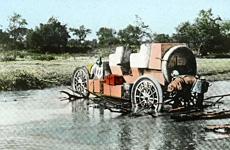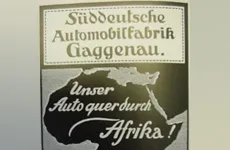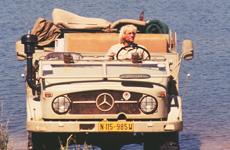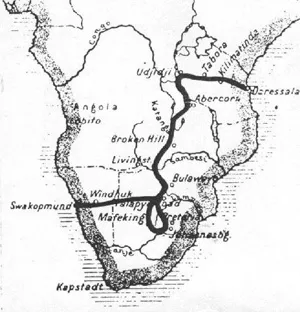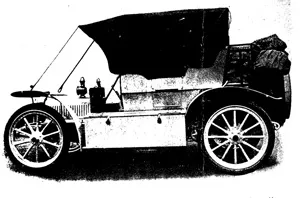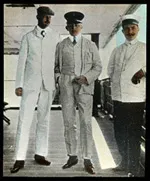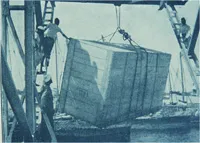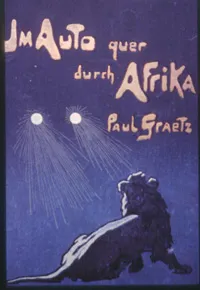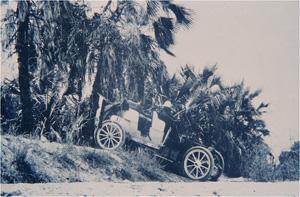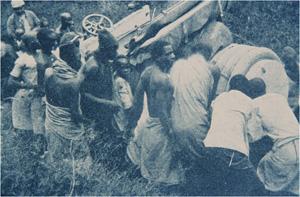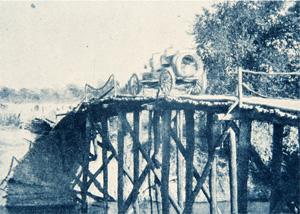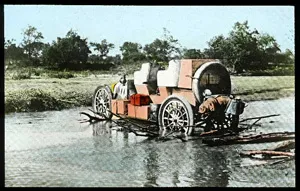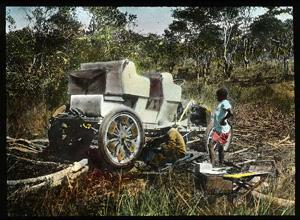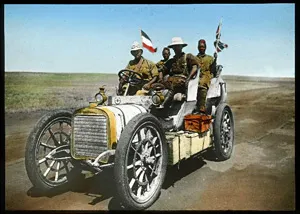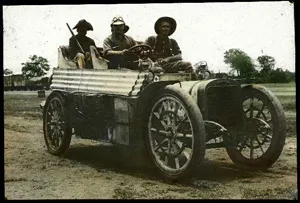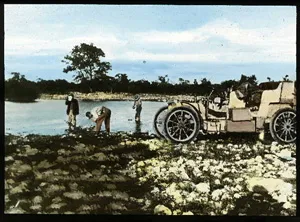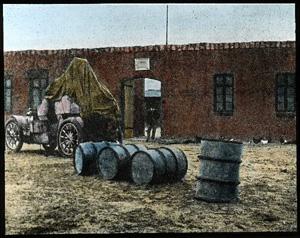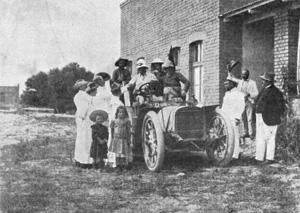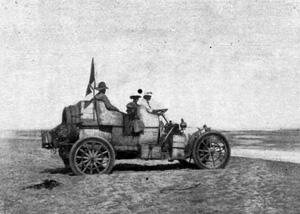Across Africa by automobile
1907 - 1909
This is a short abstract of the first transit of southern Africa undertaken by the German pioneer Paul Graetz by automobile from 1907 - 1909.
In 1907 first lieutenant Paul Graetz terminated his service for the royal army. During his term of service his duty was to build a road for motor vehicles from the coast to the border where he was stationed.
During this time all heavy materials were transported by the black locals on their heads which not only meant a loss of time but also enormous strains during constant heat, torrential rains, some ice cold nights and the ever luring danger of contracting malaria or blackwater.
During his military service in East Africa the young lieutenant became convinced that the transport problems in Africa could only be solved through the use of motorised vehicles.
Hence he started working on the idea to cross the continent from east to west by car. A fantastic idea, but it bore risks, obstacles and dangers.
There were no road maps and the distances given were measured in ‚hours on horseback“. Part of the country was invested by the deadly Tsetse fly and by mosquitos. There were no gas stations but plenty of waterless stretches. All previous attempts had failed and both men and beast had fallen victim to the Tsetse fly.
Dar-es-Salaam to Swakopmund
Graetz planned this undertaking very thouroughly.
From the "Motoren-Werke Gaggenau" in Germany (today a branch of DaimlerChrysler, where the famous Unimogs were assembled) he ordered a vehicle which was built according to his specific requirements.
The chassis was consturted in a way that it was 35 cm higher above ground than normally.
The Motoren Werke in Gaggenau engaged a mechanic to be the chauffeur, who - together with the automobile - reached Dar-es-Salaam by ship. It was a memorable day when he arrived, greeted by a somewhat doubtful c row-graetzd...
Everybody had heard about the former endeavour of Troost in South West Africa, who tried to combat the thick sands between Swakopmund and the interior of the country by „locomobile“. It ended with Martin Luther ("Here I stand. I cannot do otherwise."). In the c row-graetzd at the harbour there were some that predicted the same fate for this vehicle.
In the book "Im Auto quer durch Afrika (Across Africa by car)" published in 1910 Paul Graetz writes about the expedition.
It reflects the unimaginable efforts of a man to access southern Africa by car.
The book is a fascinating read, even though reality dominates all details.
Not only did Graetz thoroughly plan the construction of the automobile, but also the routes, the waterless areas, the conditions of the Kalahari, the mountains that had to be traversed, the rivers that had to be crossed – with or without bridges or ferries – and most importantly the fuel stations that had to be established beforehand at reachable distances.
A Boer established these stations in the Kalahari with his ox waggon.
They were marked with a wooden cross with the inscription "GRAETZ".
Graetz, von Roeder and the loyal native Mzee remained determined. The many break downs happened one after the other. Already on day six of the expedition the cylinders blew shortly after passing Morogoro.
The chauffer travelled back to Germany, but fell too ill to return with the new cylinders, as he had contracted malaria and black water fever.
The Motoren Werke in Gaggenau engaged another mechanic who unfortunately lacked experience, thus they sent their own engineer along to monitor the reparation. Now the vehicle was reassembled, this time without spotlights, exhaust and wings to reduce its weight.
After a three month break
One can only imagine the "tucke - tucke" noise the vehicle was now making. To the men it was like music to the ears after having to wait for three months for the spare parts.
Every time the expedition seemed to have reached its lowest point unexpected help was received!
They organised yoke of oxen to drag the vehicle; the kids peeled bark from the trees and made strong ropes to pull the car 250km to Lake Tanganyika.
Before reaching the target the most agonising experience was the crossing of the daunting mountain pass at Kampi ya fundi in the middle of an otherwise flat landscape.
Even the native porters had difficulties to cross the rough boulders and deep crevasses carrying the weight on their heads.
Nevertheless Graetz decided to take that route as impassable swamps spread to the left and to the right of the cliffs.
Bit by bit the automobile was dismantled only leaving the chassis which had to stay in one piece. With joint efforts a path was cleared, wide enough to allow eight Askaris who struggled under the heavy load. After three days they successfully crossed the pass and the Saline at Uvinza and Udjiji were in sight.
Across Lake Tanganyika
They crossed Lake Tanganyika by boat to Kituta Bay. Here the driver breached contract to return home.
At Bismarckburg they met a farmer who was selling fresh produce and who offered to join them. He'd heard of the existence of motor vehicles but had never seen one before! It was explained to him how the car worked and he was quick to learn, always helpful, full of humour and never tired.
Graetz taught him how to drive.
In Northern Rhodesia, nowadays Zambia, they had to wait for fuel for quite some time. They used the time on hand to do research - they found out that moles smiled when chloroformed. When hearing the singing of the natives after four weeks they felt like Columbus when he'd first sighted land after a long journey at sea. The fuel was transported in whisky bottles.
In Livingstone the farmer returned to Lake Tanganyika to harvest his fields and also the loyal Roeder had to return to Germany to his wife. A substitute driver arrived from Bulawayo.
Financial hardships
Here in Livingstone Graetz noticed that his budget was depleted. He had not received any financial support from the vehicle manufacturer nor from any newspapers and he had personally financed expedition with 75,000 Marks up to now.
The expedition which was planned for a period of six months had gone on for over a year. He was advised to sell his car to be able to pay his debts. But to sell the car after a 5000 km long journey?
With the little money he had left he paid his most urgent debts. He thought about his situation and remembered the pictures he took during the long journey: landscapes, accidents and repairs in the wild captured on film. He had kept his photos safe in all situations, whilst crossing rivers, during heavy rains, whilst being stuck in swamps.
He found a photographer who was willing to develop his films on credit. They could now become his saviour.
And they did…..
They were presented at a slide show in Johannesburg and were received with great success. They illustrated all accidents, repairs in wild landscapes, broken spokes, bent axles… one thing they were not able to show: the heat under which they had to suffer!
Friends in Port Elizabeth who did not want the public to hear about Greatz’ difficulties collected high amounts of money which enabled to complete his journey to the Atlantic Ocean.
Through the Kalahari
He had the car thoroughly checked and chauffeur no. 5 was employed. The Australian Henry Gould was an experienced man and stayed with Greatz until the end of the expedition in Swakopmund. He had excellent mechanical knowledge as well as the ability to repair things that seemed irreparable, such as broken shafts, a broken steering wheel, and a bent chassis.
As soon as they started to cross the deep sands of the Kalahari Desert, torrential rainfalls, mosquitoes, hunger and thirst were their constant companions.
During a period of thirst, Gould in despair drank fuel and fell seriously ill. Graetz watched over him day and night, fell asleep for 24 hours, got soaked by rain and crawled into his tent while Gould continued sleeping.
He awoke with high fever and shivering fits and now needed care himself.
Following the ox waggon tracks they encountered additional problems – the different with of the tracks!
When their car slipped into the ox waggon tracks it needed to be lifted out, which was strenuous work and required a lot of patience. At three of the five fuel stations they only found empty barrels. They had obviously not been sealed properly and the precious liquid had evaporated. Fortunately the engine oil and the spare tyres were in good condition.
Arrival in South West Africa
The expedition reached the English-German border at Rietfontein and Graetz parked the car with the front wheels on German soil whilst the rear wheels remained on English soil. Both flags were hoisted and the emblems put on poles. Graetz recalled with great gratitude the unlimited support that they received en route from the authorities, police officers and officials.
Messangers were sent from Rietfontein to the nearest town Gobabis. They had to find a new magneto, as even Gould was unable to ignite the old one.
The men at the outpost took good care of Graetz and Gould. The condition of their clothes revealed the deprivations of the long months and they received a much needed haircut to make them look civilized agaim. As they became impatient being so close to their goal they continued by ox waggon towards Gobabis. Gobabis was a
comparatively large station with telephone connection to Windhoek. From there two magnetos were sent and the car operational again for the final stretch.
A small welcoming was prepared in Windhoek. Graetz received his uniform which he had previously sent ahead and dressed up for the occasion, but his thoughts raced ahead…
He was surprised at the shabby and dusty roads of this “capital” which only had three vehicles. Eager to complete the journey he stayed only as long as was necessary without appearing impolite.
With only a few minor mishaps (an axle broke while passing Okahandja when it hit a hidden tree trunk, but Windhoek's commander had a new one made from the frame of a canon) they reached the Namib Desert, an unexpected sight after the lush landscapes of East Africa. Hardly any vegetation apart from the Melkbos (euphorbia) and sporadic tufts of grass.
With the loud noise of the car they reached the last dunes - in front of them stood "Martin Luther" and in the distance lay the Atlantic Ocean.
The expedition had taken 630 days!
At the hotel "Kaiserhof" Graetz received a telegram from the emperor Kaiser Wilhelm from Germany, "Well done, my dear Graetz" and one from King Edward of England to congratulate him on his success.



